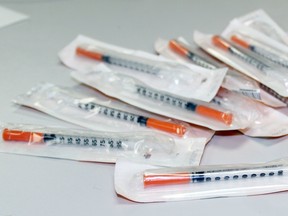Counterpoint: The evidence shows that safer supply drug programs work
Our research found that people receiving safer supply experienced fewer hospitalizations and emergency room visits. This can't be ignored

Article content
The mounting moral panic against safer supply and other harm reduction interventions to counter the toxic drug crisis is not based in evidence. The reality is safer supply works.
We are researchers who have been studying safer supply in British Columbia and Ontario for several years. Multiple published studies and program evaluations, including our own and those led by colleagues, have found that people receiving safer supply report decreased use of fentanyl from the unregulated street supply, fewer overdoses and better health and social outcomes.
Quite simply, when you get a stable dose of pharmaceutical opioids in a safer supply program, your risk of overdose goes down compared to those using fentanyl from the unregulated, toxic and volatile street supply.
Our research, using hospital data published in the Canadian Medical Association Journal in September last year, reported rapid improvements in health indicators among people receiving safer supply.
The improvements we found began immediately. Participants had fewer emergency department visits, hospitalizations and health care costs in the year after starting the program, suggesting that receiving safer supply medications led to important stabilizations in health. This is precisely the type of dispassionately-collected data that many critics have been calling for, yet it continues to be ignored.
A recent Ontario Drug Policy Research Network review of 20 published studies and program evaluations found positive health and social outcomes for people receiving safer supply. It is encouraging that this work is being conducted by multiple teams of scientists, in different provinces and using different research methods.
This evidence shows that safer supply has a crucial role to play in addressing the toxic drug crisis, alongside better and more widely available evidence-based harm reduction (which aim to reduce health and social consequences of drug use) and treatment services (which aim to treat substance use disorders), as well as decriminalization and regulation.
So why are some people calling for the end of safer supply programs, particularly those that provide take-home doses of medications?
One answer comes from looking at the history of interventions to address drug-related harm in Canada. Anytime a new program of this kind emerges, it is controversial. This is because of stigma and the ongoing criminalization of people who use drugs. It happened with methadone programs — now the gold-standard treatment for people with opioid use disorders — and when needle and syringe programs were first implemented to address the HIV crisis.
It happened again with supervised injection sites. Although Canada’s first sanctioned supervised injection site, Insite, celebrated its 20th year in operation last month, it was also one of few such sites in the country until the current overdose crisis reached emergency levels in 2016.
The slow and haphazard scale-up of life-saving interventions across the country, the lack of services outside of urban areas and the limited capacity of existing programs to meet community needs are major contributors to high rates of overdose across the country.
We have never scaled up any harm reduction interventions to meet the catastrophic increase in overdose-related deaths. While B.C. introduced a prescribed safer supply program in 2021, our best estimates are that only five per cent of people who could benefit from safer supply are able to access it. In the rest of Canada, the existing handful of programs (which run on a pilot basis through time-limited funding from the federal government) serve only a couple hundred people each.
Far from being a “wild west” of over-prescribing, there is a severe lack of services amidst a huge sea of need for safer supply and other interventions to address the toxic drug crisis.
Meanwhile, the unregulated drug supply continues to become more toxic and dangerous, killing thousands more people across the country. Increasingly toxic drugs — driven by the volatility of illicitly manufactured fentanyl — are causing the increases in overdose deaths, not the roll-out of harm reduction interventions like safer supply.
In B.C. and Ontario, fentanyl caused 85 per cent of overdose deaths in 2021-22, compared to about 30 per cent of deaths in 2015. Notably, northern cities and rural and remote areas of Canada, which often lack harm reduction programs, are seeing the highest rates of overdose deaths.
The truth about the response to the toxic drug crisis in Canada is that we’ve never scaled up any of the evidence-based interventions — harm reduction or treatment — to address the true level of need in our communities. More programs are needed to make a difference.
Debate on what’s working and not working with prescribed safer supply is healthy. Many important research projects are currently underway that will continue to inform program delivery, including studies examining the scale and impact of medications diverted from safer supply initiatives.
Moral panic against safer supply and other harm reduction interventions neglects the growing and strong evidence that safer supply has saved lives. It ignores the reality that people are dying because they can’t access evidence-based harm reduction and treatment programs — with little urgency from any level of government to treat this crisis like the public health disaster that it is.
National Post
Gillian Kolla, PhD, is a postdoctoral researcher, Brittany Barker, PhD, is a white settler scientist on Coast Salish territories, Bernie Pauly, PhD, is a nurse scientist and nursing professor and Karen Urbanoski, PhD, is an epidemiologist who holds a Canada Research Chair in substance use, addictions and health services; all are with the Canadian Institute for Substance Use Research at the University of Victoria.













Postmedia is committed to maintaining a lively but civil forum for discussion. Please keep comments relevant and respectful. Comments may take up to an hour to appear on the site. You will receive an email if there is a reply to your comment, an update to a thread you follow or if a user you follow comments. Visit our Community Guidelines for more information.